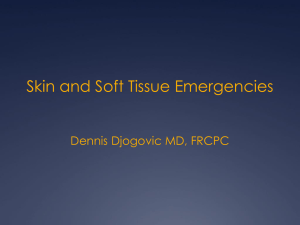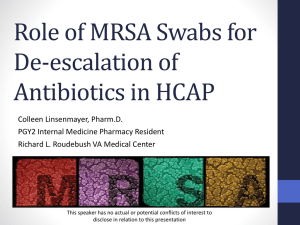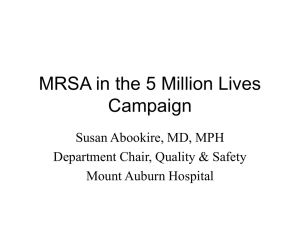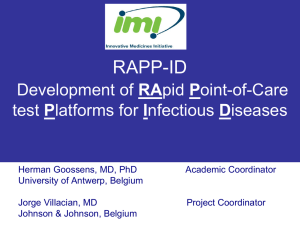Management of MRSA - IDSA - Infectious Diseases Society of America
advertisement
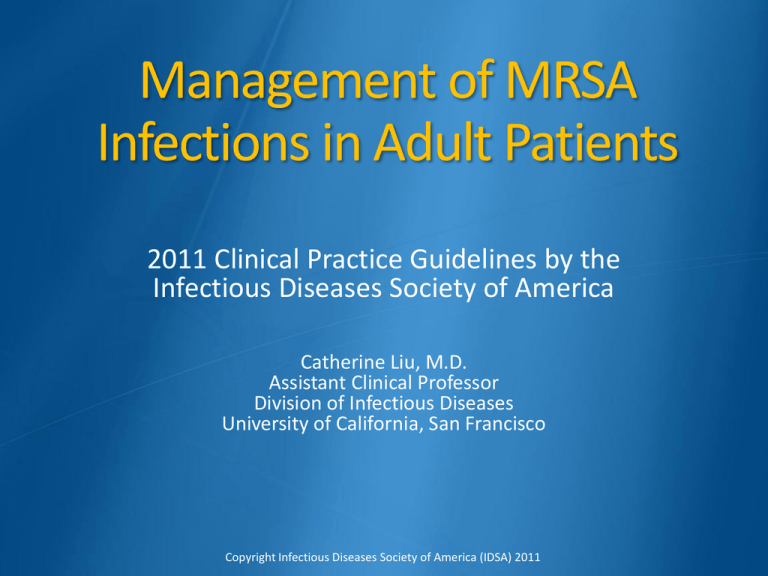
Management of MRSA Infections in Adult Patients 2011 Clinical Practice Guidelines by the Infectious Diseases Society of America Catherine Liu, M.D. Assistant Clinical Professor Division of Infectious Diseases University of California, San Francisco Copyright Infectious Diseases Society of America (IDSA) 2011 Panel Members Catherine Liu, MD Henry “Chip” Chambers, MD Arnold S. Bayer, MD Sara E. Cosgrove, MD Robert S. Daum, MD Scott K. Fridkin, MD Rachel J. Gorwitz, MD Sheldon L. Kaplan, MD A.W. Karchmer, MD Donald P. Levine, MD Barbara E. Murray, MD Michael J. Rybak, PharmD David A. Talan, MD SPGC Liaison Stan Deresinski, M.D. Copyright Infectious Diseases Society of America (IDSA) 2011 Objectives To provide evidence-based guidance to adult and pediatric clinicians managing patients with MRSA infections To discuss the management of different clinical syndromes caused by MRSA The guidelines do not address: MRSA infection prevention strategies in healthcare settings (e.g. active surveillance testing, perioperative prophylaxis) Management of outbreaks in community settings Copyright Infectious Diseases Society of America (IDSA) 2011 Background Panel first convened in 2007 Literature review performed via PUBMED between 1961-2010: mostly clinical human studies, but also experimental animal models and in vitro studies Reviewed and endorsed by the Pediatric Infectious Diseases Society, American Academy of Pediatrics, and American College of Emergency Physicians Copyright Infectious Diseases Society of America (IDSA) 2011 Clinical Topics 1. Skin and soft tissue infections 2. Recurrent skin and soft tissue infections 3. MRSA bacteremia and endocarditis 4. MRSA pneumonia 5. MRSA bone and joint infections 6. MRSA central nervous system infections 7. Role of combination or adjunctive therapies 8. Vancomycin dosing and monitoring 9. Vancomycin susceptibility testing 10. Management of persistent bacteremia and vancomycin treatment failures 11. MRSA neonatal infections Copyright Infectious Diseases Society of America (IDSA) 2011 Evidence Grading System Strength of recommendation A Good evidence to support a recommendation for or against use B Moderate evidence to support a recommendation for or against use C Poor evidence to support a recommendation Quality of evidence I Evidence from 1 properly randomized, controlled trial II Evidence from 1 well-designed clinical trial, without randomization; from cohort or case-controlled analytic studies (preferably from > 1 center); from multiple time-series; or from dramatic results from uncontrolled experiments III Evidence from opinions of respected authorities; based on clinical experience, descriptive studies, or reports of expert committees. Source: The periodic health examination. Canadian Task Force on the Periodic Health Examination. Health Canada, 1979. Adapted and reproduced with the permission of the Minister of Public Works and Government Services, Canada, 2009 Copyright Infectious Diseases Society of America (IDSA) 2011 Case 1 32 y/o M with 3 days of an enlarging, painful lesion on his L thigh that he attributes to a “spider bite”. T 36.9 BP 118/70 P 82 Copyright Infectious Diseases Society of America (IDSA) 2011 What is the appropriate management of this patient? A. Incision and drainage alone B. Incision and drainage plus oral antiMRSA antimicrobial agent C. Oral anti-MRSA antimicrobial agent Copyright Infectious Diseases Society of America (IDSA) 2011 Abscesses Incision and drainage is the primary treatment (AII). For simple abscesses or boils, I&D alone likely adequate Do antibiotics provide additional benefit? Multiple, observational studies: high cure rates with or without abx 3 RCTs of uncomplicated skin abscesses; 2 large NIH trials ongoing p=.25 cephalexin p=.12 TMP-SMX p=.52 TMP-SMX Rajendran AAC 2007; 51:4044-8; Duong Ann Emerg Med 2009;55:401-7; Schmitz Ann Emerg Med 2010; 56:283-7 Copyright Infectious Diseases Society of America (IDSA) 2011 Is clinical cure the only important endpoint? p=.04 p=.58 p=.02 Duong Ann Em Med 2009;55:401-7; Schmitz Ann Em Med 2010; 56:283-7; Talan Ann Em Med 2010; 55:412-14; Spellburg Ann Em Med 2011; 57:183-4. Copyright Infectious Diseases Society of America (IDSA) 2011 Antibiotic therapy is recommended for abscesses associated with: Severe, extensive disease, rapidly progressive with associated cellulitis or septic phlebitis Signs & sx of systemic illness Associated comorbidities, immunosuppressed Extremes of age Difficult to drain area (e.g. face, hand, genitalia) Failure of prior I&D (AIII) Copyright Infectious Diseases Society of America (IDSA) 2011 Microbiology of Purulent SSTIs non-B hemolytic strep 4% unknown 9% other 8% B-hemolytic strep 3% MSSA 17% MRSA 59% Moran NEJM 2006; 355: 666-74 Copyright Infectious Diseases Society of America (IDSA) 2011 Purulent Cellulitis: S. aureus >>> hemolytic strep Cellulitis associated with purulent drainage or exudate without a drainable abscess Empiric Rx for CA-MRSA is recommended (AII). Empiric Rx for -hemolytic strep unlikely needed (AII). Duration of therapy: 5-10 days, individualize based on clinical response (AII). Copyright Infectious Diseases Society of America (IDSA) 2011 Outpatient purulent cellulitis: Empiric Rx for CA-MRSA Drug Adult Dose Evidence Grade TMP-SMX 1-2 DS BID AII Doxycycline, Minocycline 100 BID AII Clindamycin 300-450 TID AII Linezolid 600 BID AII Copyright Infectious Diseases Society of America (IDSA) 2011 Case 2 28 year old woman presents with erythema of her right arm over past 48 hours. There is no purulent drainage, exudate or abscess. No evidence of joint or bursa involvement. T 37.0 BP 132/70 P 78 Courtesy of Thomas Sellers, MD, CDC/ Emory University Copyright Infectious Diseases Society of America (IDSA) 2011 What is the appropriate management of this patient? A. Clindamycin 300 mg PO tid B. Cephalexin 500 mg QID, monitor clinically with addition of TMP/SMX if no response C. Cephalexin 500 mg QID and TMP/ SMX 2 DS tab PO bid Copyright Infectious Diseases Society of America (IDSA) 2011 Nonpurulent Cellulitis: -hemolytic strep vs. S. aureus? Empiric Rx for -hemolytic strep recommended (AII) Prospective study1, 248 hospitalized pts 73% due to -hemolytic strep (diagnosis by serologies for ASO and anti-DNAse-B, blood cultures); 27% with no identified cause. Overall 96% response rate to -lactam antibiotic. Retrospective study2 treatment failures with TMP-SMX vs. -lactam or clindamycin The role of CA-MRSA is unknown. Empiric Rx for MRSA if fails to respond to -lactam Consider in patients with systemic toxicity 1Jeng et al Medicine 2010; 89:217-26 2Elliott et al Pediatrics 2009; 123:e959-66 Copyright Infectious Diseases Society of America (IDSA) 2011 Outpatient nonpurulent cellulitis: Empiric Rx for -hemolytic streptococci +/- MRSA Drug Adult Dose Cephalexin 500 QID Dicloxacillin 500 QID Clindamycin* 300-450 TID Linezolid* 600 BID *Also have activity against CA-MRSA Copyright Infectious Diseases Society of America (IDSA) 2011 Complicated SSTI • Surgical debridement & empiric therapy for MRSA pending cultures Antibiotic Adult Vancomycin Evidence Grade 15-20 mg/kg IV Q8-12 AI Linezolid 600 mg PO/ IV BID AI Daptomycin Telavancin Clindamycin 4 mg/kg IV QD 10 mg/kg IV QD 600 mg PO/IV Q8 AI AI AIII *Tigecycline associated with mortality; consider alternate agent for MRSA SSTI *Ceftaroline: FDA approved after guidelines Copyright Infectious Diseases Society of America (IDSA) 2011 Case 3 The patient in case 1 returns 4 weeks later with another abscess on his opposite thigh. He notes that after I & D of his first abscess, he didn’t keep his wound covered and occasionally touched the site to “make sure it was healing.” The site of his old abscess is clean with a wellhealed scar. He undergoes I&D and receives 1 week of TMP-SMX. Copyright Infectious Diseases Society of America (IDSA) 2011 What is the appropriate management of this patient? A. Emphasize personal hygiene measures B. Decolonize with mupirocin and chlorhexidine showers C. Decolonize with TMP-SMX and rifampin D. A and B E. A, B, and C Copyright Infectious Diseases Society of America (IDSA) 2011 What is the Management of Recurrent Skin and Soft Tissue Infections? Host Environment Pathogen Copyright Infectious Diseases Society of America (IDSA) 2011 What is the Management of Recurrent Skin and Soft Tissue Infections? Personal Hygiene/ Hygiene Wound Care (AIII) Host -Cover draining wounds -Hand hygiene after touching infected skin -Avoid reusing/ sharing personal items if active infection *Decolonization (CIII) Environment Pathogen Environmental Hygiene (CIII) -Clean high-touch surfaces Copyright Infectious Diseases Society of America (IDSA) 2011 -If above measures fail -If ongoing household transmission Recurrent MRSA SSTI: Decolonization Regimens Mupirocin twice daily x 5-10 days (CIII) recurrent MSSA SSTI in small RCT1 RCT military recruits: in CA-MRSA nasal colonization but not 1st time SSTI2 Mupirocin twice daily x 5-10 days AND topical skin antiseptic (e.g. chlorhexidine) x 5-14 days (CIII) RCT military recruits: CHG wipes alone not SSTI rates3, transient effect on colonization Consider dilute bleach baths: ¼ cup per ¼ tub (13 gallons) of water for 15 min, 2x/week for 3 mnths 1Raz Arch Intern Med 1996; 156:1109-12; 2Ellis MW AAC 2007; 51: 3591-8 3Whitman ICHE 2010; 12: 1207-15 Copyright Infectious Diseases Society of America (IDSA) 2011 Oral Antibiotics for Decolonization? Not routinely recommended for decolonization (AIII). An oral agent in combination with rifampin (if susceptible) may be considered if infections recur despite other measures (CIII). Cochrane review1: No benefit of oral abx in MRSA eradication among patients in healthcare settings Systematic review2: Rifampin + staph abx vs. staph abx alone Rifampin combo superior in S. aureus colonization No studies evaluated impact on infection rates Watch out for drug interactions, side effects, resistance 1Cochrane Review 2003; 4CD003340 2Falagas ME AJIC 2007; 35: 106-14 Copyright Infectious Diseases Society of America (IDSA) 2011 Case 4 35 y/o F previously healthy with 4 days of fever, chills, myalgias, and cough. Now with increasing dyspnea and hemoptysis x 24 hrs T38.7 P120 BP96/60 R24 89%RA Moderate respiratory distress with coarse rhonchi WBC 15, Hct 44, Plt 425 Rapid flu: + influenza A Sputum gram stain/ cx: pending Intubated, admitted to ICU Courtesy of Thomas File MD Copyright Infectious Diseases Society of America (IDSA) 2011 In addition to starting anti-influenza therapy, would you treat with antibiotics and if so which? A. None B. Ceftriaxone and azithromycin C. Vancomycin and ceftriaxone and azithromycin D. Linezolid and cefepime Copyright Infectious Diseases Society of America (IDSA) 2011 MRSA pneumonia Antibiotic Adult Evidence Grade AII Vancomycin Linezolid 15-20 mg/kg IV Q8-12 600 mg PO/ IV BID AII Clindamycin 600 mg PO/IV TID BIII Jung Crit Care Med 2010 Copyright Infectious Diseases Society of America (IDSA) 2011 MRSA pneumonia: Vancomycin vs. Linezolid? p= NS p= NS •No difference in microbiologic success rates •No difference in eradication rates of MRSA 1Rubinstein p <.01 p <.03 •Limitations of post-hoc analysis prevent drawing definitive conclusions CID 2001;32:402-12; 2Wunderink Clin Therap 2003;25:980-92; 3Wunderink Chest 2003;124:1789-1797 Copyright Infectious Diseases Society of America (IDSA) 2011 MRSA pneumonia Daptomycin should not be used for Rx of pneumonia, (inactivated by pulmonary surfactant) Daptomycin may be used in patients with hematogenous septic pulmonary emboli1 Empiric Rx for MRSA recommended for severe CAP (ICU admission, necrotizing or cavitary infiltrates, or empyema) Discontinue empiric Rx if cultures do not grow MRSA Duration of therapy: 7-21 days 1Rehm JAC 2008;62:1413-21; Silverman JID 2005; 191:2149-52 Copyright Infectious Diseases Society of America (IDSA) 2011 Case 5 60 year old male prison inmate presents with 4 days of fevers and chills and decreased L eye vision. T 38.5 BP 102/71 P 104 R 20 O2 sat 98% RA weight 100 kg Eye: Bilateral creamy white-yellow discharge, vitreous strands/ infiltrates, L eye - intraretinal hemorrhage Heart: 2/6 systolic murmur at apex Chest: CTAB Skin: no peripheral stigmata of endocarditis Labs: 15.5> 39 > 350 Cr 0.8 Started on IV vancomycin 1 gram every 12 hours Copyright Infectious Diseases Society of America (IDSA) 2011 Case continued HD #1 blood cx: 3/4 MRSA (vanco MIC 1) Received intravitreal injection of vancomycin HD # 5 T 37.8 BP 138/70 P 113 R 16 O2 sat 96% RA Alert and interactive, no new physical exam findings Blood cx: 2/2 MRSA (vanco MIC 1) Vancomycin trough 7 g/mL Copyright Infectious Diseases Society of America (IDSA) 2011 Echocardiogram 2 cm mitral valve vegetation Copyright Infectious Diseases Society of America (IDSA) 2011 Brain MRI Copyright Infectious Diseases Society of America (IDSA) 2011 What changes to the patient’s antibiotics should be made? A. Add gentamicin to vancomycin B. Add rifampin to vancomycin C. Increase vancomycin dose to 1.5 gram IV Q12 hrs, target goal trough of 15-20 g/mL D. Discontinue vancomycin and start IV daptomycin 6 mg/kg Q24 hrs Copyright Infectious Diseases Society of America (IDSA) 2011 MRSA bacteremia and endocarditis IV vancomycin (AII) or IV daptomycin 6 mg/kg QD (AI). 236 pts randomized to IV daptomycin 6 mg/kg QD vs. (vancomycin or nafcillin) + gentamicin 1 mg/kg Q8 x 4 days Some experts recommend IV daptomycin 8-10 mg/kg QD (BIII). Fowler VG NEJM 2006; 355: 653-65 Copyright Infectious Diseases Society of America (IDSA) 2011 Is there a role for adjunctive gentamicin or rifampin? More is not always better… Addition of gentamicin (AII) or rifampin (AI) to vancomycin is not recommended. No clear evidence of benefit. Vanco +rifampin: 1 RCT MRSA endocarditis1 Vancomycin Vancomycin + rifampin p-value Treatment failures 4/ 22 (18%) 2/20 (10%) >.05 Median duration of bacteremia 7 days (5-11) 9 days (6-13) >.05 Median duration of fever 7 days (3-8) 7 days (3-10) >.05 Vanco + gentamicin: in vitro data, but no clinical studies. Nafcillin + gent vs. nafcillin RCT MSSA bacteremia: duration of bacteremia x 1 day but no difference in morbidity/ mortality2 1Levine. Ann Intern Med 1991;115:674-80; 2Korzeniowski. Ann Intern Med 1982;4:496-503 Copyright Infectious Diseases Society of America (IDSA) 2011 Addition of gentamicin or rifampin to vancomycin is associated with toxicity risk of nephrotoxicity with initial low-dose gentamicin1 *Gentamicin was an independent predictor of clinically significant in CrCl risk of elevated transaminases (≥ 5X baseline), drug interactions with rifampin, resistance concerns2 1Fowler NEJM 2006;355:653-65; Cosgrove S CID 2009;48:713-21; 2Riedel D AAC 2008;52:2463-7 Copyright Infectious Diseases Society of America (IDSA) 2011 MRSA bacteremia and endocarditis: Source control is critical Identify source and extent of infection; eliminate and debride other sites of infection (AII). Repeat blood cultures 2-4 days after initial positive cultures and as needed thereafter to document clearance of bacteremia (AII). Echocardiography recommended for all patients with bacteremia (AII). TEE is preferred over TTE. Evaluate for valve replacement surgery if: vegetation > 10 mm, ≥ 1 embolic event, severe valvular insufficiency, valvular perforation, decompensated heart failure, perivalvular/ myocardial abscess, new heart block Copyright Infectious Diseases Society of America (IDSA) 2011 Duration of therapy Lower success rates in pts receiving < 14 days of therapy have been observed Uncomplicated bacteremia: Minimum duration is 2 weeks if: Exclude endocarditis No implanted prostheses (e.g. prosthetic valves, cardiac devices, arthroplasties) Negative follow-up blood cultures for MRSA at 2-4 days Defervescence within 72 hours of therapy No evidence of metastatic sites of infection Complicated bacteremia (if do not meet above criteria): 4-6 weeks 1Fowler NEJM 2006;355:653-65; Cosgrove CID 2008;46:S386-93 Copyright Infectious Diseases Society of America (IDSA) 2011 Vancomycin Dosing IV vancomycin 15-20 mg/kg (actual body weight) every 8-12 hrs, not to exceed 2 g per dose (BIII). In seriously ill patients with suspected MRSA infection, a loading dose of 25-30 mg/kg (actual body weight) may be considered (CIII). Given risk of red man syndrome and possible anaphylaxis associated with large doses, consider prolonging infusion time 2 h and pre-medication with antihistamine . Continuous infusion vancomycin is unlikely to substantially improve patient outcome, compared with intermittent dosing (AII). Copyright Infectious Diseases Society of America (IDSA) 2011 Vancomycin Therapeutic Drug Monitoring Obtain serum troughs at steady state (b/f 4th or 5th dose) (BII). Monitoring of peak vancomycin concentrations is not recommended (BII). For serious infections (e.g. bacteremia, endocarditis, osteomyelitis, pneumonia, severe SSTI [nec fasc]), target vancomycin trough concentrations of 15-20 g/mL (BII). For most patients with SSTI with normal renal function and not obese, traditional doses of 1 g Q12 are adequate and trough monitoring is not required (BII). Moise-Broder Clin Pharmacok 2004;43:925-42; Jeffres Chest 2006; 130:947-55; Arbeit R CID 2004;38:1673-81; Weigelt AAC 2005; 49:2260-6; Stryjewski CID 2008;46:1683-93; Lipsky JAC 2005;55:240-5; Breedt AAC 2005; 49:4658-66 Copyright Infectious Diseases Society of America (IDSA) 2011 Targeting Higher Vancomycin Troughs: What is the Evidence? pK/pD: Higher troughs likelihood of achieving target AUC/ MIC AUC/ MIC ≥ 400 vs. <400 associated with improved clinical/ microbiologic response1 2 Mean Trough Mean AUC 9.4 µg/mL 318 ± 111 µg/h/mL 20.4 µg/mL 418 ± 152 µg/h/mL Resistance: Lower troughs may select for resistant subpopulations (e.g. hVISA)3. Clinical outcomes: Unclear correlation between troughs4 Further clinical study is needed Watch for potential nephrotoxicity 1Moise-Broder Clin Pharmacok 2004;43:925-42; 2Jeffres Chest 2006; 130:947-55 2Charles P CID 2004;38:448-51; 3Jeffres M Chest 2006; 4Hidayat L Arch Intern Med 2006;166:2138-44; Lodise AAC 2008;52:3315-20; Maor JID 2009;199:619-24 Copyright Infectious Diseases Society of America (IDSA) 2011 A few words on Vanco MICs…. Mohr CID 2007;44:1536-42 Probability of achieving target AUC/ MIC is 0% if vancomycin MIC = 2 µg/mL with low or high-dose vancomycin Vanco MICs of 2 µg/mL associated with vanco Rx failures1 “MIC creep” observed in some centers but not others2 Perhaps due to clonal dissemination or technical artifact 1Sakoulas JCM 2004;42:2398-402; Hidayat L Arch Intern Med 2006;166:2138-44; Lodise AAC 2008;52:3315-20; Maor JID 2009;199:619-24 2Alos JAC 2008;62:773-5; Holmes AAC 2008;52:757-60; Jones CID 2006;42:S13-24; Sader AAC 2009; 53:4127-32 Copyright Infectious Diseases Society of America (IDSA) 2011 Vancomycin Susceptibility Testing There is considerable variability in MIC results depending on method used Certain methods (Etest, Microscan, BD-Phoenix) report higher MICs than reference methods while others (Sensititre and Vitek 2) tend to undercall resistance Acceptable variability for MIC methods is +/one doubling dilution (e.g. is MIC of 1 really 2 or vice versa?) Swenson JCM 2009; 47:2013-7 Copyright Infectious Diseases Society of America (IDSA) 2011 Detection of Isolates with Vancomycin MIC of ≤ 2 µg/mL N=1800 Sader AAC 2009; 53:4127-32 Copyright Infectious Diseases Society of America (IDSA) 2011 How should Vancomycin MIC Results be used to Guide Therapy? For isolates with a vanco MIC ≤ 2 µg/mL, the patient’s clinical response should determine continued use of vancomycin, independent of the MIC (AIII). If clinical and microbiological response to vanco, continue with close follow-up If no clinical or microbiologic response despite adequate debridement and removal of other foci of infection, alternative to vancomycin is recommended regardless of MIC. For isolates with a vancomycin MIC 2 µg/mL (VISA or VRSA), an alternative to vancomycin should be used (AIII). Copyright Infectious Diseases Society of America (IDSA) 2011 Case continued… Vancomycin dose increased to 1.5g Q 12 hours HD #6 blood cx: 2/2 MRSA (vanco MIC 1), vanco trough 13 (drawn before 3rd dose) HD #8 blood cx: 2/2 MRSA (vanco MIC 1, dapto MIC ≤ 0.5) HD #9 blood cx: prelim 1/ 2 Staph spp T37.2 BP132/84 HR94 R18 O295-100% RA R eye –retinal detachment No other significant changes to physical exam Repeat Echo: vegetation size with longer mobile element and extension along the annulus Copyright Infectious Diseases Society of America (IDSA) 2011 In addition to CT surgery eval, what changes to the patient’s antibiotics, if any, should be made? A. No changes to his antibiotics should be made B. Add gentamicin to vancomycin C. Discontinue vancomycin and start IV daptomycin 8 mg/kg Q24 hrs D. Discontinue vancomycin and start IV daptomycin 8 mg/kg Q24 hrs + linezolid 600 mg BID Copyright Infectious Diseases Society of America (IDSA) 2011 Defining Vancomycin Treatment Failure: Approach to Persistent MRSA Bacteremia Median time to clearance of bacteremia1,2,3: MSSA with -lactam abx 3-4 days MRSA with vancomycin, daptomycin 7-9 days Consideration factors when contemplating change in therapy: Patient’s overall clinical response Vancomycin trough concentrations Results of susceptibility testing (e.g. vanco MIC) Presence of and ability to remove other foci of infection 1Korzeniowski Ann Intern Med 1982;4:496-50; 2Levine Ann Intern Med 1991;115:674-80; 3Fowler NEJM 2006;355:653-65 Copyright Infectious Diseases Society of America (IDSA) 2011 Management of Persistent MRSA Bacteremia on Vancomycin Therapy Consider change in therapy if: 1) Unsatisfactory clinical response, regardless of MIC or 2) Vanco MIC = 2 1 2 3 4 5 6 7 No change in therapy if: 1) Clinically responding and 2) Vanco MIC < 2 8 9 10 Day of vancomycin therapy Copyright Infectious Diseases Society of America (IDSA) 2011 11 12 13 Persistent MRSA Bacteremia/ Vancomycin Treatment Failures: Therapeutic Considerations In general, recommend a change in therapy rather than addition of other agents (e.g. rifampin/ gentamicin) to vanco High-dose daptomycin (10 mg/kg/day), if susceptible, in combination with another agent (BIII): Gentamicin 1 mg/kg IV Q8 Rifampin 600 mg PO/ IV QD or 300-450 mg PO/ IV twice daily Linezolid 600 mg PO/ IV BID TMP-SMX 5 mg/kg IV BID -lactam antibiotic Note: prior vanco exposure and elevated vanco MICs associated with dapto MICs (> 1 µg/mL). LaPlante K AAC 2004;48:4665-72;Tsuji BT AAC 2005;49:2735-45;Credito AAC 2007;51:1504-7; Baltch A AC 2008;52:182933;Rose W AAC 2008;52:831-6;Falagas ME JAC 2006;58:273-80;Steed AAC 2010;54:5187-92;Yang AAC 2010; 54:3161-9 Copyright Infectious Diseases Society of America (IDSA) 2011 How to manage reduced susceptibility to vancomycin and daptomycin? Quinupristin-dalfopristin 7.5 mg/kg/dose IV Q8 (CIII) Used successfully in vanco Rx failures, but lower response rates for endocarditis and bacteremia of unknown source TMP-SMX 5 mg/kg/dose IV BID (CIII) In vitro study: combo of dapto + TMP-SMX vs. dapto alone had more rapidly bactericidal activity for a dapto non-susceptible strain Linezolid 600 mg PO/ IV BID (CIII) Case series suggest success when used alone or in combination with other abx; poor outcomes for left-sided endocarditis. Telavancin 10 mg/kg/dose IV QD (CIII) 1 case report of persistent MRSA bacteremia successfully treated Sander A Int Care Med 2002;28:1157-60; Markowitz N Ann Intern Med 1992;117:390-8; Steed AAC 2010;54:5187-92; Falagas ME JAC 2006;58:273-80; Nace JAC 2010;65:1315-6. Copyright Infectious Diseases Society of America (IDSA) 2011 Case follow-up HD #9 blood cultures: 1/ 2 MRSA Daptomycin + linezolid started R vitrectomy performed HD #11 blood cultures : negative HD #15 OR for valve replacement surgery Intraoperative cultures mitral valve vegetation: + MRSA Complicated course: status epilepticus, ventilatorassociated pneumonia, PEA arrest 2 to submassive PE, eventually recovered and discharged to SNF Received daptomycin 10 mg/kg QD + rifampin 300 mg TID for 6 weeks after MVR. Copyright Infectious Diseases Society of America (IDSA) 2011 MRSA bone and joint infections Surgical debridement is mainstay of therapy (AII). Antibiotic Dose Evidence grade Vancomycin 15-20 mg/kg IV Q8-12 BII Daptomycin 6 mg/kg IV QD BII Linezolid 600 mg PO/ IV BID BII TMP-SMX + rifampin 4 mg/kg/dose (TMP) BID 600 mg QD (rifampin) BII Clindamycin 600 mg PO/ IV Q8 BIII Some experts recommend adding rifampin 300-450 BID: Animal models, small human trials of MSSA osteomyelitis Retrospective study: cure rate of 80%, no added benefit if debridement occurred Perlroth Arch Intern Med 2008;168:805-19;Dombrowski J Infect 2008;57:110-5; Livorsi J Infect 2008;57:128-31 Copyright Infectious Diseases Society of America (IDSA) 2011 Oral vs. IV vs. IV/ PO therapy? Optimal route of administration not established (AII). Chronic non-axial MSSA osteo, randomized trial1 Cure rate IV cloxacillin PO cotrimoxazole + (6 wks IV/ 2 wks PO) rifampin X 8 wks P-value 91% 1.0 89% Retrospective cohort (MRSA subset)2 Cure rate IV (median 6 wks)* IV (median 2 wks), then P-value PO (median 42 days) 65% 65% .99 *61 % also received oral therapy for median PO 21 days ** Median total duration of total therapy 60 and 56 days in both groups 1Euba AAC 2009;53:4305-10; 2Daver J Infect 2007;54:539-44 Copyright Infectious Diseases Society of America (IDSA) 2011 Duration of therapy? Optimal duration is unknown; minimum 8 wks (AII). Hematogenous MSSA vertebral osteo: 8 wks vs < 8 wks1,2 associated with improved outcomes Some experts suggest an additional 1-3 months (and possibly longer for chronic infection or if no debridement) of oral rifampin-based combination therapy (CIII) 1Jensen Arch Intern Med 1998;158:509-17; 2Priest S Med J 2005;98:854-62 Copyright Infectious Diseases Society of America (IDSA) 2011 MRSA Infections of the Central Nervous System Treatment difficult due to blood-brain barrier Antibiotic CSF penetration Vancomycin 1-5% (BII) CSF concentration Comment 2-6 µg/mL Some experts recommend adding rifampin1 (BIII) Linezolid (BII) 66% Peak 7-10 µg/mL Trough 2.5-6 µg/mL Successful use in few case reports, small case series2 TMP-SMX (CIII) TMP 13-53% SMX 17-63% TMP 1.9-5.7 µg/mL SMX 20-63 µg/mL Few case reports, only MSSA3 1Von Specht EJCMID 2006;25:267-9; Dylewski J CJIDMM 2004;15:336-8; Pintado EJCMID 2002;21:864-8; 2Ntziora Ann Pharm 2007;41:296-308; Gallagher J Infect 2008;57-410-3; 3Vartzelis Infect 2005;33:36-8; Levitz Ann Intern Med 1984; 100:881-90 Copyright Infectious Diseases Society of America (IDSA) 2011 Management of MRSA infections of the Central Nervous System CNS Shunt infections/ meningitis Shunt removal is recommended; replace only when CSF cultures are repeatedly negative (AII). Intraventricular vancomycin or daptomycin may be considered if not responding to systemic therapy1. Brain abscess, subdural empyema, spinal epidural abscess Neurosurgical evaluation for incision and drainage (AII). Septic cavernous or dural venous sinus thrombosis Debride contiguous sites of infection or abscess (AII). Role of anticoagulation controversial due to risk of intracranial hemorrhage 1Pfausler J Neurosurg 2003;98:1040-4; Amod J Infect 2005; 50:252-7;Elvy JAC 2008;61:46102 Copyright Infectious Diseases Society of America (IDSA) 2011 Adjunctive Therapies in Treatment of MRSA Infections Protein synthesis inhibitors (e.g. clindamycin and linezolid) and IVIG are not routinely recommended as adjunctive therapy (AIII). Limited in vitro data, animal model data (some conflicting) Some experts may consider these agents in selected scenarios (e.g. necrotizing pneumonia or severe sepsis.) (CIII). Copyright Infectious Diseases Society of America (IDSA) 2011 Performance Measures The management of all MRSA infections should include identification, elimination, and/or debridement of the primary source and other sites of infection when possible In patients with MRSA bacteremia, document clearance of bacteremia (follow-up blood cultures 2-4 days after initial positive cx and as needed thereafter) Vancomycin should be dosed according to actual body weight (15-20 mg/kg/dose every 8-12h), not to exceed 2 gram per dose. Target trough of 15-20 g/mL in patients with serious infections Document in vitro susceptibility when an alternative to vancomycin is being considered For MSSA infections, a -lactam antibiotic is the drug of choice Copyright Infectious Diseases Society of America (IDSA) 2011 Conclusion It is important to realize that guidelines cannot always account for individual variation among patients. They are not intended to supplant physician judgment with respect to particular patients or special clinical situation. IDSA considers adherence to its guidelines to be voluntary, with the ultimate determination regarding their application to be made by the physician in the light of each patient's individual circumstances. The full text of the guideline can be found at: http://www.idsociety.org/IDSA_Practice_Guidelines/ Copyright Infectious Diseases Society of America (IDSA) 2011
